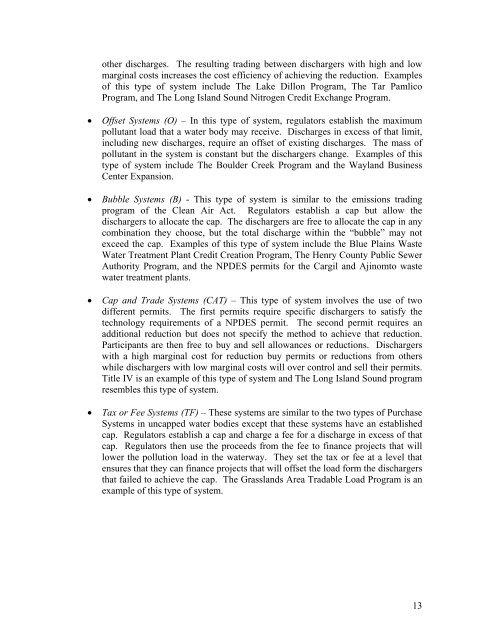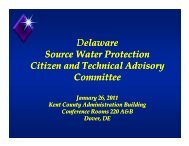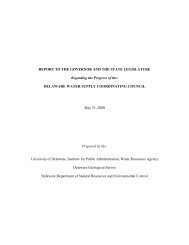Water Quality Trading in the Lower Delaware River Basin: A ...
Water Quality Trading in the Lower Delaware River Basin: A ...
Water Quality Trading in the Lower Delaware River Basin: A ...
You also want an ePaper? Increase the reach of your titles
YUMPU automatically turns print PDFs into web optimized ePapers that Google loves.
o<strong>the</strong>r discharges. The result<strong>in</strong>g trad<strong>in</strong>g between dischargers with high and low<br />
marg<strong>in</strong>al costs <strong>in</strong>creases <strong>the</strong> cost efficiency of achiev<strong>in</strong>g <strong>the</strong> reduction. Examples<br />
of this type of system <strong>in</strong>clude The Lake Dillon Program, The Tar Pamlico<br />
Program, and The Long Island Sound Nitrogen Credit Exchange Program.<br />
• Offset Systems (O) – In this type of system, regulators establish <strong>the</strong> maximum<br />
pollutant load that a water body may receive. Discharges <strong>in</strong> excess of that limit,<br />
<strong>in</strong>clud<strong>in</strong>g new discharges, require an offset of exist<strong>in</strong>g discharges. The mass of<br />
pollutant <strong>in</strong> <strong>the</strong> system is constant but <strong>the</strong> dischargers change. Examples of this<br />
type of system <strong>in</strong>clude The Boulder Creek Program and <strong>the</strong> Wayland Bus<strong>in</strong>ess<br />
Center Expansion.<br />
• Bubble Systems (B) - This type of system is similar to <strong>the</strong> emissions trad<strong>in</strong>g<br />
program of <strong>the</strong> Clean Air Act. Regulators establish a cap but allow <strong>the</strong><br />
dischargers to allocate <strong>the</strong> cap. The dischargers are free to allocate <strong>the</strong> cap <strong>in</strong> any<br />
comb<strong>in</strong>ation <strong>the</strong>y choose, but <strong>the</strong> total discharge with<strong>in</strong> <strong>the</strong> “bubble” may not<br />
exceed <strong>the</strong> cap. Examples of this type of system <strong>in</strong>clude <strong>the</strong> Blue Pla<strong>in</strong>s Waste<br />
<strong>Water</strong> Treatment Plant Credit Creation Program, The Henry County Public Sewer<br />
Authority Program, and <strong>the</strong> NPDES permits for <strong>the</strong> Cargil and Aj<strong>in</strong>omto waste<br />
water treatment plants.<br />
• Cap and Trade Systems (CAT) – This type of system <strong>in</strong>volves <strong>the</strong> use of two<br />
different permits. The first permits require specific dischargers to satisfy <strong>the</strong><br />
technology requirements of a NPDES permit. The second permit requires an<br />
additional reduction but does not specify <strong>the</strong> method to achieve that reduction.<br />
Participants are <strong>the</strong>n free to buy and sell allowances or reductions. Dischargers<br />
with a high marg<strong>in</strong>al cost for reduction buy permits or reductions from o<strong>the</strong>rs<br />
while dischargers with low marg<strong>in</strong>al costs will over control and sell <strong>the</strong>ir permits.<br />
Title IV is an example of this type of system and The Long Island Sound program<br />
resembles this type of system.<br />
• Tax or Fee Systems (TF) – These systems are similar to <strong>the</strong> two types of Purchase<br />
Systems <strong>in</strong> uncapped water bodies except that <strong>the</strong>se systems have an established<br />
cap. Regulators establish a cap and charge a fee for a discharge <strong>in</strong> excess of that<br />
cap. Regulators <strong>the</strong>n use <strong>the</strong> proceeds from <strong>the</strong> fee to f<strong>in</strong>ance projects that will<br />
lower <strong>the</strong> pollution load <strong>in</strong> <strong>the</strong> waterway. They set <strong>the</strong> tax or fee at a level that<br />
ensures that <strong>the</strong>y can f<strong>in</strong>ance projects that will offset <strong>the</strong> load form <strong>the</strong> dischargers<br />
that failed to achieve <strong>the</strong> cap. The Grasslands Area Tradable Load Program is an<br />
example of this type of system.<br />
13




